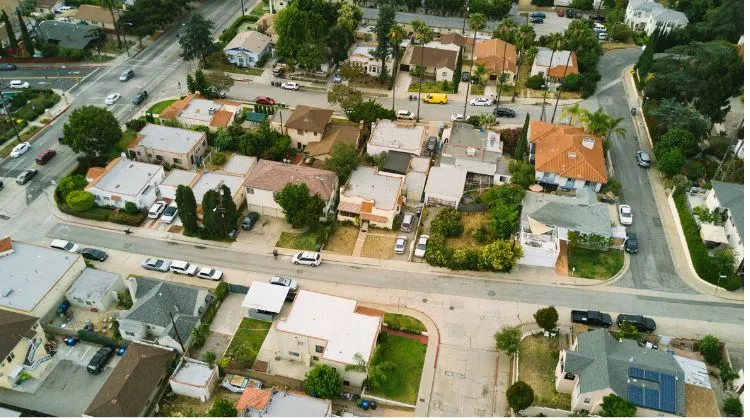
It can feel confusing trying to figure out finances. You might wonder if your earnings place you in a certain category. Understanding what is considered low income in the United States is a big part of this puzzle.
Many people ask this question. They want to know where they stand and what help might be available. This topic isn’t as simple as one fixed number, as many factors can change the answer.
This information matters if you’re looking for help with housing, food, or healthcare. Knowing what is considered low income in the United States can open doors to programs that offer support for individuals and families.
Table of Contents:
- What Exactly Does “Low Income” Mean?
- Why “Low Income” Isn’t One-Size-Fits-All
- The Government’s Take: Poverty Guidelines vs. Income Limits
- How Income is Assessed for Eligibility
- Exploring What is Considered Low Income in the United States: A Closer Look at Programs
- Beyond the Numbers: The Real-Life Impact of Low Income
- How Do I Know If My Income Qualifies as Low?
- Where to Find Help if You’re Low Income
- Common Misconceptions about Low Income
- Frequently Asked Questions
- Conclusion
What Exactly Does “Low Income” Mean?
The term “low income” describes individuals and families earning less than a certain amount. This amount isn’t set nationally for all purposes; it changes based on several important factors. So, there is no single dollar figure that defines low income for everyone in the country.
Different government agencies and federal office branches use their own guidelines and poverty measure. The Department of Health and Human Services (HHS) issues the federal poverty guidelines. The Department of Housing and Urban Development (HUD) sets income limits for its housing assistance programs.
These definitions are vital because they help direct assistance to those who need it most. It’s a way to try and make things fair. But it also means you have to look at the right definition for your specific situation and the specific assistance program you are interested in.
The Census Bureau plays a crucial role by providing data that informs these figures, particularly the poverty thresholds, which are a statistical measure.
Why “Low Income” Isn’t One-Size-Fits-All
The definition of low income shifts quite a bit. One big reason is your household size. A single person has a different income threshold than a family of four.
Where you live also makes a huge difference; this is a key factor for determining eligibility for many programs. Living in a big city on the coast is usually more expensive. This is different from living in a rural area in the Midwest, where the cost of living may be lower.
Consequently, income limits are often higher in places with a higher cost of living. States and even counties can have their own specific numbers because the cost to live can vary so much from one place to another. What’s low income in New York City is very different from low income in a small town in Alabama; the poverty guidelines apply differently based on geography.
The Government’s Take: Poverty Guidelines vs. Income Limits
Two main sets of figures often come up: HHS poverty guidelines and HUD income limits. They sound similar but are used for different things. It’s good to know the difference, as this can help you understand which numbers apply to you when determining eligibility.
HHS Poverty Guidelines
The Department of Health and Human Services issues federal poverty guidelines each year. These are a key federal poverty level indicator. They are used for determining eligibility for many federal programs and represent a baseline income level.
Programs that often use these guidelines include Head Start, the Supplemental Nutrition Assistance Program (SNAP), and parts of Medicaid. The numbers are based on family size; for instance, the 2024 poverty guideline for a family of four in most states might be around $31,200. You can find the most current figures on the HHS website, which is the official source for this poverty measure.
It’s important to know these are guidelines for the 48 contiguous states and the District of Columbia. Alaska and Hawaii have their own separate poverty guidelines because living costs there are greater; these separate figures reflect office considerations for these unique states. These separate poverty figures are updated annually by the federal government to account for inflation.
The poverty guidelines serves as an administrative tool for program eligibility. These guidelines are a simplification of the poverty thresholds for administrative use. The original version of these guidelines stemmed from work initiated by the Office of Economic Opportunity in the 1960s, reflecting an ongoing economic opportunity administrative practice to define and address poverty.
Specific guidelines also apply to territories like Puerto Rico, the Virgin Islands, American Samoa, Guam, and the Northern Mariana Islands. These areas may use the mainland guidelines or have adjustments based on local economic conditions, ensuring the poverty guidelines apply appropriately across all U.S. jurisdictions including the Marshall Islands and Mariana Islands.
Census Bureau Poverty Thresholds
While HHS issues guidelines for program administration, the actual poverty thresholds are maintained by the Census Bureau. These poverty thresholds are the original statistical measure of poverty in the United States. They are updated annually for inflation using the Consumer Price Index.
The Census Bureau’s poverty thresholds are more detailed than the HHS guidelines. They vary by family size, the number of children, and, for one- and two-person units, by the age of the householder (e.g., the aged/non-aged distinction for units). For example, there are specific thresholds for non-aged one-person units and various two-person units.
These thresholds are primarily used for statistical purposes, such as calculating the number of people in poverty each year. HHS then adapts these poverty thresholds to create the simplified federal poverty guidelines used by programs. Understanding this distinction between the statistical poverty threshold and the administrative poverty guideline is important.
The complex structure includes different percentage multiples for various family configurations, such as non-aged units, to accurately reflect different needs. This detailed poverty measure is crucial for accurate poverty statistics.
HUD Income Limits
The Department of Housing and Urban Development (HUD) sets income limits mainly for housing assistance programs. This includes programs like public housing or Section 8 housing choice vouchers. HUD’s numbers are often a bit more complex than HHS guidelines.
HUD defines low income in tiers, such as “extremely low income,” “very low income,” and “low income.” These are typically based on percentages of the Area Median Income (AMI) for a specific county or metropolitan area. For example, low income might be 80% of AMI, very low income 50% of AMI, and extremely low income 30% of AMI.
The AMI is the midpoint of a region’s income distribution, meaning half of households earn more than the AMI, and half earn less. HUD calculates AMIs for every part of the country. You can check specific income limits for your area using HUD’s tools, often found on HUDuser.gov.
Because these are tied to local median incomes, they reflect local economic conditions much better. For example, limits for Hawaii reflect office data and local cost of living adjustments specific to the state. This approach aims to make housing help fair across diverse economic landscapes by adjusting to local economic opportunity.
How Income is Assessed for Eligibility
When programs assess if your income qualifies as low, they look at specific types of income and documentation. Generally, programs consider gross income, which is your income before taxes and most deductions. This includes wages, salaries, tips, self-employment income, unemployment benefits, and other forms of regular cash income.
Income from social security benefits, including retirement, disability, and survivor benefits, is usually counted. Pensions and retirement account withdrawals may also be included. Some programs might also look at certain assets, though rules vary widely; often primary homes and one vehicle are excluded.
Interest from savings, dividends from stocks, or earnings from cd rates might be considered income. The treatment of assets like the cash value of life insurance policies can differ, with some programs having asset limits and others not. It is important to check the specific requirements of each assistance program.
To verify income, programs typically require documentation like recent pay stubs, employer letters, or copies of your income tax forms. Self-employed individuals might need to provide profit and loss statements or other business records. Providing accurate and complete information is essential for determining eligibility.
Exploring What is Considered Low Income in the United States: A Closer Look at Programs
Understanding what is considered low income in the United States becomes clearer when we see how programs use these limits. Many federal programs exist to help people who meet these income qualifications. Each one will have its own specific rules and income cutoffs based on either the federal poverty level or Area Median Income.
Let’s look at a few common examples:
- Supplemental Nutrition Assistance Program (SNAP): SNAP, often referred to as food stamps, is a key nutrition assistance program. This supplemental nutrition assistance program helps low-income people buy food. Eligibility often depends on meeting certain gross and net income limits, generally based on the federal poverty level, though states may have some flexibility in how they apply these rules for supplemental nutrition assistance.
- Medicaid: This program gives health coverage to millions of Americans. This includes eligible low-income adults, children, pregnant women, elderly adults, and people with disabilities. Income eligibility for Medicaid can vary a lot from state to state, with some states having expanded Medicaid to cover more low-income adults under the Affordable Care Act.
- Section 8 Housing Choice Vouchers: This HUD program helps very low-income families, the elderly, and the disabled afford decent housing in the private market. Local public housing agencies (PHAs) determine eligibility based on HUD’s income limits. Typically, a family’s income must not exceed 50% of the AMI for their area to qualify for this housing assistance.
- Low Income Home Energy Assistance Program (LIHEAP): LIHEAP helps eligible low-income households with their home heating and cooling costs. It can also help with bill payment assistance, energy crisis assistance, and weatherization services. States set specific income eligibility, often a percentage of the federal poverty guidelines or state median income.
- Special Supplemental Nutrition Program for Women, Infants, and Children (WIC): WIC is another important nutrition assistance program that supports pregnant women, new mothers, infants, and young children up to age five. It provides nutritious foods, nutrition education, breastfeeding support, and healthcare referrals. Income eligibility for WIC is typically between 100% and 185% of the federal poverty guidelines.
- Head Start and Early Head Start: These programs promote school readiness for children from low-income families. Eligibility criteria often include head start specific income guidelines based on the federal poverty level. Determining eligibility for Head Start also considers factors like homelessness or foster care status; eligibility include head start services like education, health, and nutrition.
- National School Lunch Program (NSLP) and School Breakfast Program (SBP): These programs provide nutritionally balanced, low-cost or free lunches and breakfasts to children each school day. The national school lunch program and SBP use income guidelines based on the federal poverty level. Eligibility for the school lunch or national school lunch free or reduced-price meals often requires family income to be at or below 130% (free) or 185% (reduced-price) of the poverty level.
It’s always best to check directly with the specific assistance program you are interested in. They can give you the most accurate and up-to-date income requirements for your specific situation and location. Your local social services office or a federal office can often point you in the right direction for applying.
Beyond the Numbers: The Real-Life Impact of Low Income
Knowing the definition of low income is one thing; living with low income is another. It affects many parts of daily life. The challenges can be significant for individuals and families striving for economic opportunity.
Housing insecurity is a major concern. Finding affordable, safe housing can be a constant struggle. Families might live in overcrowded conditions or face eviction, which impacts everyone, especially children.
Food insecurity, often addressed by supplemental nutrition programs, is also common. This means not always having access to enough food for an active, healthy life. Families may have to choose between paying rent and buying groceries, leading to nutritional deficiencies and health problems.
Accessing healthcare can be tough. Even with programs like Medicaid, out-of-pocket costs can be a burden. Preventive care might be skipped, leading to more serious health issues later on, and dental or vision care are often out of reach for many.
Educational opportunities can be limited. Children in low-income families might attend under-resourced schools, affecting their long-term learning and future job prospects. Higher education might seem like an impossible dream due to costs, although programs like Head Start aim to mitigate early disadvantages.
Stress is a constant companion for many dealing with financial hardship. Worrying about how to make ends meet takes a toll on mental and physical health. It can feel like you are always just one unexpected bill away from a crisis.
These are just some of the realities people face. They highlight why understanding and addressing low income is so important. Support programs are not just handouts; they are crucial lifelines that can improve administrative practice in delivering aid.
How Do I Know If My Income Qualifies as Low?
Figuring out if your income is considered low can seem like a puzzle. But you can take steps to find out. First, you need to know your household’s gross monthly or annual income before taxes and other deductions.
Next, identify your household size, which includes everyone you support financially who lives with you. The income limits are different for different household sizes. A family of four will have a higher income limit than a single person due to differing needs.
Then, you can look up the relevant figures for determining eligibility. For general poverty information, check the HHS poverty guidelines for your state and household size on the HHS website; remember that Alaska and Hawaii have separate poverty guidelines. Reviewing your income tax documents can help gather income information.
If you’re interested in housing help, you’ll need HUD’s income limits. You can use HUD’s online lookup tool at HUDuser.gov by entering your state and county. This will show you specific income limits for various housing programs in your location.
Many programs also have online screening tools or calculators that can give you a preliminary idea if you might qualify. Always remember these are just estimates. You’ll still need to formally apply for a program, often using your tax forms or pay stubs, to get an official decision.
Where to Find Help if You’re Low Income
If you find that your income falls into the low-income category, know that help is available. Many resources are out there. The key is knowing where to look and not being afraid to ask.
A great starting point is Benefits.gov, a government website with a benefits finder tool. You can answer some questions about your situation, and it shows you programs you might be eligible for. This can simplify finding an assistance program.
Local community action agencies are also valuable. These non-profit organizations work to fight poverty at the local level, often through an economic opportunity administrative practice focus. They often run various programs or can connect you to resources in your area; you can find your local agency through the Community Action Partnership website.
Food banks and pantries provide food assistance to those in need, supplementing programs like SNAP. Feeding America has a nationwide network of food banks, and you can use their website to find one near you. Many churches and local charities also offer food help, an essential form of nutrition assistance.
If you’re facing legal issues related to housing or benefits, Legal Aid societies may help. They give free or low-cost legal services to eligible individuals. The Legal Services Corporation (LSC) funds many of these organizations across the country.
Don’t forget to check with your state or county social services department. They administer many federal and state assistance programs, such as the supplemental nutrition assistance program or Medicaid. They can provide information and help with applications, though it can feel overwhelming, taking that first step to ask for help is important.
Common Misconceptions about Low Income
Several common misconceptions exist regarding what it means to be low income in the United States. One frequent misunderstanding is that “low income” is a single, fixed number applicable nationwide. As discussed, it varies significantly by location, household size, and the specific program in question.
Another misconception is that only unemployed individuals are considered low income. Many low-income individuals and families are working, sometimes multiple jobs, but their earnings are insufficient to meet basic living costs. The term “working poor” describes this situation.
Some believe that being low income automatically means having no assets. While some programs have asset limits, these often exclude a primary home, one vehicle, and modest savings. The focus is primarily on income as the poverty measure for eligibility for most assistance programs.
It’s also mistakenly thought that assistance programs are easy to access or provide lavish benefits. In reality, application processes can be complex, and benefits are typically modest, designed to supplement resources, not fully replace income. Understanding the facts helps to dispel these myths.
Frequently Asked Questions
Many individuals have frequently asked questions about low income and poverty guidelines. Here are answers to some commonly asked questions. These frequently asked points can clarify some confusion.
What is the difference between poverty guidelines and poverty thresholds?
Poverty thresholds are the original version of the federal poverty measure, issued by the Census Bureau for statistical purposes, like tracking the number of people in poverty. The poverty guidelines, issued by HHS, are a simplification of the thresholds used for administrative purposes, specifically for determining eligibility for federal programs. The poverty guidelines serves as the practical tool for programs.
How often are these figures updated?
Both the poverty thresholds and the federal poverty guidelines are updated annually. Poverty thresholds are updated by the Census Bureau to account for inflation using the Consumer Price Index. HHS then issues updated poverty guidelines early each year, typically in January or February.
Does my social security income count towards income limits?
Yes, in most cases, income from social security benefits (retirement, disability, survivors) is counted when determining eligibility for low-income assistance programs. However, some specific programs might have exceptions or disregard certain types of income, so it’s always best to check the program’s specific rules. For example, some energy assistance programs might not count all of it.
What if my income changes during the year?
If your income changes significantly during the year, it may affect your eligibility for assistance programs. You are generally required to report such changes to the agency administering your benefits. A decrease in income might make you newly eligible for help, while an increase could make you ineligible or change your benefit amount.
Are there different poverty guidelines for places like Puerto Rico or the Virgin Islands?
Yes, while the 48 contiguous states and DC use one set of federal poverty guidelines, Alaska and Hawaii have separate, higher guidelines due to their higher cost of living. Territories like Puerto Rico, Guam, the U.S. Virgin Islands, American Samoa, and the Northern Mariana Islands also have specific considerations; they might use the contiguous U.S. guidelines or have other adjustments as determined by federal law or program regulations.
Conclusion
Understanding what is considered low income in the United States is not always straightforward. It involves various poverty guidelines, federal poverty level calculations, factors like household size and geographic location, and regional differences. But knowing this information is a critical first step toward economic opportunity for many.
This knowledge can help you identify potential support systems if you are facing financial difficulties. Many assistance programs, including the supplemental nutrition assistance program, Medicaid, and housing aid, use these income levels as a poverty measure to determine who can get much-needed help. Ultimately, these poverty guidelines and income limits are tools to connect individuals and families with resources that can make a significant difference in their lives.




Leave a Reply